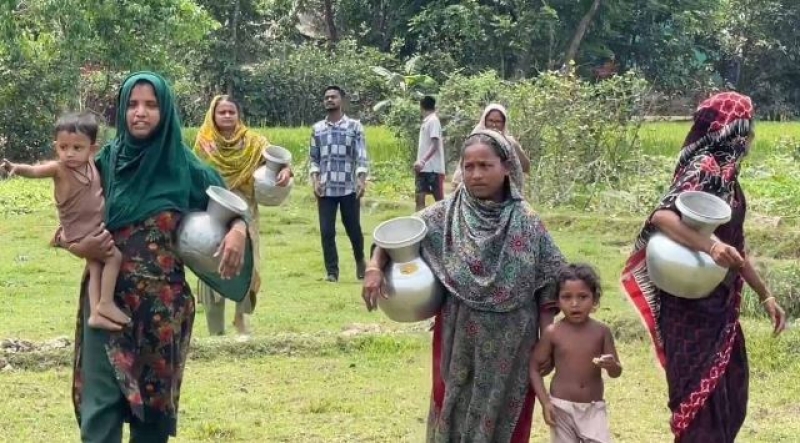- Brazil Launches Fund to Protect Forests and Fight Climate Change |
- UN Warns Conflicts Are Devastating Ecosystems Worldwide |
- Flood-hit Kurigram char residents see little hope in politics, elections |
- Air quality of Dhaka continues to be ‘unhealthy’ Friday morning |
- BNP pledges to implement signed July Charter |
Over 1.67 lakh tube wells go dry amid drinking water problem in Feni
Irrigation seriously affected as ground water level falls

Women look for sources of safe drinking water as their shallow tube wells have gone dry in Feni
Feni, Apr 13 - An alarming crisis of fresh water has gripped Feni, with more than 1.67 lakh tube wells across the coastal district running dry amid intense heat and prolonged drought.
Tens of thousands of residents are without access to safe drinking water, face serious public health risks and agricultural output is threatened for lack of irrigation water.
According to the Feni District Public Health Engineering Department (DPHED), water is unavailable in 1,67,386 tube wells due to the underground water layer dropping significantly. The crisis has intensified in several upazilas where around 70% of tube wells have stopped producing water, and people are forced to fetch water from distant sources or consume unsafe water from ponds and ditches—risking outbreaks of diarrhoea and other waterborne diseases.
“There is no water in tube wells, ponds, canals, or beels. Rain is the only solution,” said the department’s Executive Engineer Md Shafiul Haque. He attributed the crisis to climate change, excessive groundwater extraction for agriculture, and the absence of rain, which has caused the water table to fall drastically year after year. “If it rains, the water layer will rise again, and water will be available,” he added.
Of the 36,811 registered tube wells in Feni, 9,871 have been long out of order. Among the remaining 26,941 active wells, nearly half have dried up. Additionally, more than half of approximately two lakh shallow tube wells installed privately are no longer producing water.
In August last year, devastating floods damaged 16,415 tube wells completely and 27,600 partially, and many of these have yet to be restored or repaired, according to SM Mahfuzur Rahman, sub-assistant Engineer at DPHED Feni.
“This has further worsened the safe water shortage in flood-affected areas,” he said.
A visit to Fulgazi Upazila revealed a grim picture: shallow tube wells at depths of 40–50 feet have completely dried up, leaving about 15,000 tube wells out of service. Many residents now travel long distances for water, and farmers are anxious about their Boro paddy yield due to the drought.
“We spent so much on planting Boro rice seedlings, but cracks are forming in the soil due to the heat and lack of rain. Now we’re unsure if we’ll get a proper harvest,” said a local resident.
Mohammad Abdullah Arman, sub-assistant Engineer at Fulgazi Upazila’s Public Health Engineering Department, said the upazila has 1,061 government shallow tube wells, 1,188 deep ones, and 887 submersible pump-equipped wells across 87 villages in six unions. In addition, there are about 17,000 private tube wells, 70% of which are no longer lifting water. “There’s no alternative system in place, so rainwater is our only hope,” he added.
In GM Hat Union, the situation is dire. Kulsum Akter Sharifa, a resident of Sharifpur village’s Kazi Bari, said five out of 11 families have deep tube wells, but none are yielding safe water. “We’re suffering terribly trying to collect water for drinking and cooking. We’re forced to fetch water from distant sources.”
Anis, a resident of Bosikpur in the same union, reported that none of the 35 deep tube wells in Sri Chandra Pur village are functioning. “This is the reality in almost every ward of our union. We have no safe water,” he said.
Khokon Chandra Patwari, another local, said the deep tube well inside the GM Hat Union Parishad building has been out of order for three years. “The water table has dropped, causing this crisis. If the government provides alternative solutions, people will benefit.”
Similar conditions prevail in Sonagazi, Parshuram, Chhagalnaiya, and Sadar upazilas, where tube wells have dried up and residents are trekking long distances for water. Many are forced to drink unsanitary pond or ditch water, falling ill with diarrhoea and other diseases.
Karimullah, a farmer from Pathan Nagar, said, “We have planted hybrid paddy, but the panicles are turning into husk due to water scarcity. All sources—ponds, canals, reservoirs—have dried up. Even BADC is unable to provide irrigation water now.”
In Daganbhuiyan Upazila, locals say that due to heightened salinity in tube well water, it is no longer drinkable.
Feni Deputy Commissioner Saiful Islam said the district administration will work with the Public Health Engineering Department to prepare a list of non-functional tube wells and arrange water supply to remote areas.
The crisis may affect upto a million people (10 lakh) in the district that has a total population of 1.7 million people (17 lakh) according to the 2022 census. - UNB

